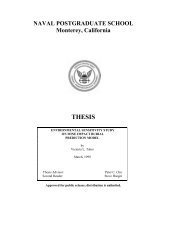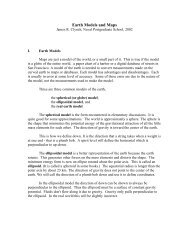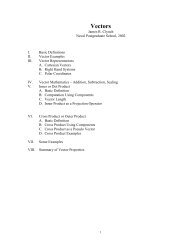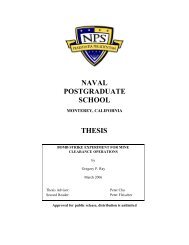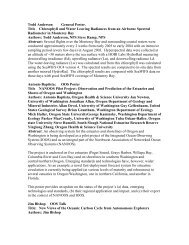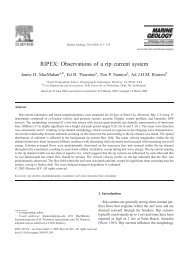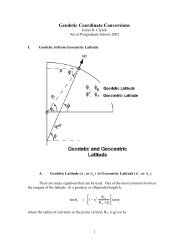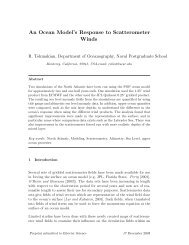System for Mine Disposal - NPS Department of Oceanography
System for Mine Disposal - NPS Department of Oceanography
System for Mine Disposal - NPS Department of Oceanography
Create successful ePaper yourself
Turn your PDF publications into a flip-book with our unique Google optimized e-Paper software.
IEEE SYSTEMS JOURNAL, VOL 8, No. 1, MARCH 2014 43Conceptual Design <strong>of</strong> Future Undersea UnmannedVehicle (UUV) <strong>System</strong> <strong>for</strong> <strong>Mine</strong> <strong>Disposal</strong>Kwang sub Song, Senior Member, IEEE, and Peter C. ChuAbstract—A conceptual design is proposed <strong>for</strong> an effectivemine countermeasure (MCM) system, which consists <strong>of</strong> threeunmanned underwater vehicles (UUVs) and 10–20 small chargeddeliverable vehicles. New underwater optical communicationsystems are introduced to improve onboard mine reconnaissanceand decision making with the key technologies focused on systemand communication efficiency, capability <strong>of</strong> data processing,and cost-effectiveness <strong>of</strong> MCM systems. The proposed UUVMCM system is cost-effective due to adapting disposable mineneutralization instruments, upgrading data process units, andconfiguring optical communication systems between heterogeneousunderwater and surface vehicle units in operations. Atthe same time, efficient and reliable underwater optical andelectromagnetic wave communication systems are also introducedand analyzed <strong>for</strong> future system applications.Index Terms—Conceptual system design, mine disposalsystem, system effectiveness, unmanned underwater vehicle(UUV) technology.I. IntroductionTHE SEA MINE, one <strong>of</strong> the most cost-effective navalweapons, represents a significant threat even to the mostsophisticated warships. While originally equipped with a simplecontact mechanism, it gradually became more advanced[1], [2], incorporating a range <strong>of</strong> smart detonators. A widevariety <strong>of</strong> mine types are deployed today, and many <strong>of</strong>them are highly sophisticated [3]–[5]. Although mines attackindividual targets, their effects can be far-reaching at fleet andtheater levels. In practical conditions, a naval <strong>for</strong>ce at seamight be obliged to modify its course <strong>of</strong> action due to theperceived or actual presence <strong>of</strong> mines. The disproportionateeffect <strong>of</strong> a single mine strike might be enough to threatenmission accomplishment <strong>of</strong> combat <strong>for</strong>ces. Some potentialimpacts <strong>of</strong> enemy mining operations include loss or delayin the arrival <strong>of</strong> carrier-based air power, amphibious assault<strong>for</strong>ces, equipment, and supplies prepositioned afloat or ashore,and logistic support carried on either naval or supportingcommercial vessels.Manuscript received July 14, 2011; revised February 17, 2012 and April20, 2012; accepted April 23, 2012. This work was supported jointly by theOffice <strong>of</strong> Naval Research, under Grant N0001412WX20510, and by the NavalOceanographic Office, under Grant N6230611PO00123P.The authors are with the <strong>Department</strong> <strong>of</strong> <strong>Oceanography</strong>, Naval PostgraduateSchool, Monterey, CA 93943 USA (e-mail: kssong@nps.edu;pcchu@nps.edu).Color versions <strong>of</strong> one or more <strong>of</strong> the figures in this paper are availableonline at http://ieeexplore.ieee.org.Digital Object Identifier 10.1109/JSYST.2012.22105921932-8184/$31.00 c○ 2012 IEEESo far, the mine countermeasure (MCM) missions havebeen executed by dedicated surface vessels and organic airborneoperations with helicopter squadrons. With maneuveringhelicopters, airborne mine neutralization system (AMNSYS),organic airborne and surface influence sweep, rapid airbornemine countermeasure system, and airborne laser mine detectionsystem operations are executed <strong>for</strong> major naval littoralor expeditionary MCM and marine amphibious operations.These operations are only possible <strong>for</strong> secured sea lanes <strong>of</strong>communication or ships with very shallow water operation.Enough distance <strong>for</strong> stand<strong>of</strong>fs and a wired communicationand control connection are required <strong>for</strong> more clandestineand effective mine neutralization operations in mine disposaloperations [6].Military <strong>for</strong>ces in the future will fight in conflicts rangingfrom major theater war to smaller scale contingencies. Naval<strong>for</strong>ces will <strong>of</strong>ten be on the leading edge <strong>of</strong> such operationsas they combine strategic mobility with maneuverability tosignificantly expand the battle space deep into the enemyterritorial seas. Many tactical operations including special<strong>for</strong>ce operations, no matter big or small, should be carriedout with time sensitiveness and clandestine operations [7].The unmanned underwater vehicle (UUV) provides strategicand operational advantages to the Navy and security <strong>for</strong>ces byreducing the cost and human risk significantly in the MCMoperations, as well as by extending the reach <strong>of</strong> in<strong>for</strong>mation,surveillance and reconnaissance. These UUV systems, whichcan be launched <strong>of</strong>f the naval plat<strong>for</strong>m, <strong>of</strong>fer significant protectionagainst major threats including naval mines [8]. Withthe state-<strong>of</strong>-the-art technology developments [9], it is possibleto perceive conceptual design ideas <strong>for</strong> future MCM UUVsystems with safety, high effectiveness, and cost-effectivesystems.In this paper, we design an MCM unit with three UUV systemsexecuting clandestine MCM operations with <strong>for</strong>midableautonomy in the deep sea in enemy territory. With the powerfuldata processing capability, networked between UUVs and themother ship through electrooptic and acoustic communications,and a new type <strong>of</strong> disposal scheme, the proposed MCMunit is linked into a network <strong>of</strong> unmanned asset and combatsystem elements. These systems provide a complete unmannedfleet fulfilling multiple operational requirements in mine disposaloperations with least human operator interactions.The status <strong>of</strong> underwater mine disposal systems is reviewedin Section II. A design <strong>of</strong> a prospective MCM system isdepicted in Section III. A conceptual design <strong>for</strong> a future mine
SONG AND CHU: CONCEPTUAL DESIGN OF FUTURE UUV SYSTEM FOR MINE DISPOSAL 45Fig. 1.Conceptual design process.Payloads <strong>for</strong> MCM vehicles generally consist <strong>of</strong> a maneuveringsystem, neutralization charges <strong>for</strong> elimination <strong>of</strong>bottom mines, or cable cutters <strong>for</strong> moored mines. Auxiliarytechnology equipment as a part <strong>of</strong> payload is also playing animportant role in enhancing the computer graphic and visualizationcapabilities. The payloads contribute greatly to sensorintegration, simulation, decision making, and training. Thecommander must have the capability to avoid mines or achievethe assured destruction or neutralization <strong>of</strong> a mine threat withinthe absolutely minimum time. The mine sweeping system mustbe effective against buried, bottom, moored, or floating minesfrom the deep water to the anti-invasion zone on the beach.There are several state-<strong>of</strong>-the-art weapon systems to dispose<strong>of</strong> the mines effectively and economically, such as laser guns,acquire guns, and small charge delivery devices.IV. Conceptual Design <strong>for</strong> Future <strong>Mine</strong><strong>Disposal</strong> UUV <strong>System</strong>The conceptual design <strong>for</strong> the futuristic MCM UUV systemis developed with operational and technical prospects based oninvestigation <strong>of</strong> a wide spectrum <strong>of</strong> current MCM operations.For complex systems such as MCM UUV units, there is noclear boundary between requirement and design. In general, ahigh-level design on the UUV systems <strong>for</strong> MCM operationsis developed from an abstract specification to detailed specification.The concept <strong>of</strong> system configuration is proposed inresponse to some perceived possible problems in the minewarfare (MIW) and operational concept <strong>for</strong>mulation.Fig. 1 shows the conceptual design process <strong>for</strong> general systems.The key system design concepts from analyzing missions<strong>of</strong> a future MCM UUV system are structural configurationsand effectiveness <strong>of</strong> system operations [17]. An objective <strong>of</strong>system design is to build cost-effective and efficient MCMUUV systems, which can operate in permissive littoral andashore environments with water depth <strong>of</strong> 10–90 m, includingharbors and shipping channels. These systems will utilizeknown tactical and target in<strong>for</strong>mation, which is preacquiredby previous MCM reconnaissance troops and assets with about75 h <strong>of</strong> endurance and over 160 km <strong>of</strong> operational range.Generally, in a conceptual vehicle design, two sets <strong>of</strong>input parameters are needed: mission description and vehicleconfiguration options [18]. A vehicle mission is divided intouser-prescribed discrete segments. Each segment is defined byits unique parameters, which include vehicle conditions, hotelpower, payload conditions, and environmental conditions. Thevehicle configuration options are generally obtained fromvehicle’s top level requirements and the concept <strong>of</strong> operations(CONOPS). Collaboration between the highly object-orientedautonomous vehicle configurations and the low-cost mine neutralizationUUV is viewed as an essential element <strong>of</strong> reliablemine neutralization operations [18]. Guidance, navigation, andcontrol <strong>of</strong> UUV instrument configuration are implemented automaticallyto derive an optimal detailed mission path plan byprocessing navigation sensors, such as sonar imagery, position,range, bearing, and underwater database in<strong>for</strong>mation [19].A. CONOPSMain concepts <strong>of</strong> MCM operations using UUV systemsare to reduce threats <strong>for</strong> the naval fleet through employinga robust, highly autonomous vehicle unit, which is capable <strong>of</strong>engagement and execution <strong>of</strong> mine sweeping or neutralizationprocedure. The neutralization procedure entails either movingthe mine out <strong>of</strong> the original place or precise delivery <strong>of</strong>the charged device to blast previously localized mines, involume, drift, floating, and bottom mines in the deep andshallow water zones [20], [21]. The proposed MCM UUVsystem unit is over the horizon launching system which hasa master UUV and two expandable slave UUVs at the twosides <strong>of</strong> the master UUV. The large master UUV has a mainmission control unit and <strong>for</strong>med charge that can reach andexplode designated mines. The two slave UUVs have variousmine detection and search sensor systems, which can improvemine detection or identification and provide cooperativemaneuvering using stereoscopic viewing. This system greatlyenhances the maneuvering capability especially in the case <strong>of</strong>no communication such as in accident. The two slave UUVsprovide maneuvering <strong>of</strong> the master UUV using stereoscopicviews.Be<strong>for</strong>e actual mine disposal activities, the control unit <strong>of</strong>the master UUV requests confirmation <strong>of</strong> mine identificationto the mother ship via acoustic and radio frequency (RF)communication links. Responding to the reply, the masterUUV deploys a charged payload, which is a small and fastguided device with high-power <strong>for</strong>med charge with proxysense running a straight course to the identified mine targets.The MCM UUV unit will have, overall, 75 h <strong>of</strong> endurance at3 knots maneuvering and 160 km <strong>of</strong> operational range.In the envisioned CONOPS, an MCM UUV unit uses itshigh-capacity communication links to receive available targetedmine in<strong>for</strong>mation from the MCM operation center at themother ship. The vehicle initiates an adaptive engagement planautonomously along its trajectory with available in<strong>for</strong>mationfrom own navigation sensors. It navigates accurately to thedesignated mine target in compensating winds, waves, andcurrents along the disposal range. All the way to the designatedmine position, the launched disposal device identifies thetargets from the sonar image. After neutralizing the designatedmine, the UUV unit per<strong>for</strong>ms a neutralization damage assessmentand reports that the mission has been accomplished.
46 IEEE SYSTEMS JOURNALFig. 2.Operations <strong>of</strong> MDUSU.B. Structural Configuration <strong>of</strong> a 3-UUV <strong>Mine</strong> <strong>Disposal</strong> UnitThe mission description <strong>of</strong> MCM fleet operation is dividedinto five segments: launch, transit, execution <strong>of</strong> mission,return transit, and recovery. Each <strong>of</strong> them is defined by keymission and environmental parameters, such as range, speed,sea current, obstacles, and underwater terrain. The description<strong>of</strong> vehicle hardware configurations is parameterized withtypical undersea vehicle’s fineness ratio: values <strong>of</strong> three, fiveand seven, indicating the ratio <strong>of</strong> length to diameter. Largevariations in mission distance and ground speed result innonpragmatic scenarios. The options <strong>for</strong> vehicle hardwareconfiguration dictate the set <strong>of</strong> vehicle design variations, whichare evaluated by the design requirements. Important optionsare the fineness ratio and block coefficient, which dictate thebasic packaging and sizing <strong>of</strong> all other vehicle subsystems.These kinds <strong>of</strong> shape and hard stuffs would be characterizedlater in a detailed actual design phase. In the conceptual designphase, several key per<strong>for</strong>mance functional characteristics <strong>of</strong>major MCM operations are investigated.C. Configuration <strong>of</strong> the Master UUV <strong>System</strong>The proposed mine disposal UUV system unit (MDUSU)demonstrates a number <strong>of</strong> capabilities, supporting autonomousmine detection, identification, and intervention using systemautonomy, communication endurance, and small chargedelivery vehicles (SCDV). Advanced technologies <strong>for</strong> thesecapabilities include situational reactive intelligent missioncontrol suits, smart sensor systems, dynamic intelligent dataclassification processes, precise inertial undersea navigation,and compact vehicle autonomous management subsystems[22].Improvement <strong>of</strong> vehicle functionality and mission effectiveness<strong>of</strong> MCM UUV system unit are the primary objectives <strong>of</strong>this research. The MCM UUV unit provides autonomy <strong>of</strong> vehiclesystems through incorporation with a plat<strong>for</strong>m-independentautonomous controller that supports high degree <strong>of</strong> autonomy,highly precise low-power navigation, and machine vision insupport <strong>of</strong> automatic classification [23].1) Mission Management Unit: Mission control architectures<strong>of</strong> MDUSU embrace various degrees <strong>of</strong> perceptions,intelligent control, and management to define sense-plan-actor sense-react behaviors. The MDUSU architecture and itsrelationships to the executors and the data or signal processingare shown in Fig. 2. Functional limitations <strong>of</strong> vehicle sensorsystems imposed by the combat environment require alternativerates <strong>of</strong> vehicle control, which defined mission goals tobe factored in the control system appropriately. A commonapproach to mission implementation is to develop functionsthat are grouped and sequenced to per<strong>for</strong>m overall tasks.These approaches can be grouped as task-oriented controlarchitectures with tasks ranging from simple to complex.Application <strong>of</strong> the defined tasks to accomplish a complex mobilerobot behavior becomes a function <strong>of</strong> sequencing. Muchresearch has been completed in architectures with required differentdegrees <strong>of</strong> sequencing. These architectures range fromstate-defined multilayered integration to near-chaotic independentfunction execution approaches. The emerging paradigmwith a three-level architecture is embodied in a number <strong>of</strong>UUV mission management algorithms. This system providesthe planning or specification <strong>of</strong> operations at the abstract level,a level <strong>of</strong> functionality that facilitates the abstraction, and alevel that provides the actual functionality [23].MDUSU embraces this hybrid mission control and vehiclemanagement architecture. It refines a traditional perceptionactionloop, allows signal processing <strong>for</strong> a low-level sensor,and extracts features to assist mission planner and controlsystem. The management system <strong>of</strong> MDUSU focuses on objectclassification and dynamic repositioning, which optimizes theaspect relative to the designated mine target. Obstacle avoidanceacquires relatively sparse sensor data in the dynamicconstruction <strong>of</strong> world models. Combining the perception orclassification with dynamical position sensors via a highly
SONG AND CHU: CONCEPTUAL DESIGN OF FUTURE UUV SYSTEM FOR MINE DISPOSAL 47TABLE IIComparison <strong>of</strong> Different Technologies <strong>for</strong> Underwater CommunicationAcoustic Communications Electromagnetic Communications Optical CommunicationsNominal speed (m/s) 1500 Light-speed Light-speedPower loss 0.1 dB/m/Hz 28 dB/1 km/100 MHz TurbidityBandwidth kHz MHz 10–150 MHzFrequency band kHz MHz 10 14 –10 15 MHzAntenna size 0.1 m 0.5 m 0.1 mEffective range km 10 m 10–100 mTechnology Mature New Newmaneuverable plat<strong>for</strong>m, MDUSU has the capability to perceivethe object <strong>of</strong> interest from multiple perspectives that increasethe probability <strong>of</strong> classification <strong>for</strong> the mine targets. A keyconcept in MDUSU data fusions includes the employment <strong>of</strong>heuristic knowledge, which incorporates constraint knowledgeassociated with target characteristics and vehicle capabilities.It provides a basis <strong>for</strong> interaction with the object <strong>of</strong> interestand dynamic perceptions <strong>for</strong> active sensor management andvehicle path planning.2) Mapping and Navigation Unit: The system’s capability<strong>of</strong> precise navigation and large sensor data collection is criticalin ensuring operations and achieving system objectives. Toresolve the vehicle position at the submeter level, a compactlow-power solid state inertial measurement unit (IMU) is incorporated.This unit measures the change <strong>of</strong> 3-D velocity andangular velocity, and temperature as well to correct thermallyinduced drift. The IMU is augmented by a compact Dopplersonar using the Kalman filter or other filtering techniques.Navigational accuracy <strong>of</strong> MCM UUV unit may be furtherenhanced through the integration <strong>of</strong> long-baseline or ultrashortbaseline acoustic navigation in<strong>for</strong>mation [24]. Precision navigationcompass and clinometers provide heading in<strong>for</strong>mationand navigation frame correction data.SLAM techniques as navigational tools are adapted <strong>for</strong> reconfirmation<strong>of</strong> designated mine localizations and autonomousnavigation with obstacle avoidance in a safe margin. All thein<strong>for</strong>mation from sensors is filtered, processed, and distributed<strong>for</strong> navigation, SLAM, and mine neutralization procedure [25].With updated environmental 3-D map and obstacle in<strong>for</strong>mation,MDUSU can be guided and controlled in an optimal pathto the targets with accuracy.3) Data Processing and <strong>Mine</strong> Classification Unit: Analgorithmic approach in data processing is used with machineperceptions, recognitions <strong>of</strong> acquired data, and featureextraction via real-time image processing. It will supportautomatic classification <strong>of</strong> mines and other ordnances, aswell as intelligence navigations using data from navigationsensors [26]. The image processing techniques, which havebeen adapted from video image and sensor signal processing,focus on classification <strong>of</strong> mines by recovery <strong>of</strong> explicit featurebaseddescriptions <strong>of</strong> manmade objects [27]. All the data fromtraditional navy database library systems on MIW, MCM, andtactical oceanography are also installed in main processing unit<strong>of</strong> MDUSU and fed into the identification and classificationprocessors [28].4) SCDV Unit: When the matser UUV <strong>of</strong> MDUSU reachesthe safe stand<strong>of</strong>f range from the mine field after relocalizationand confirmation <strong>of</strong> predesignated mine or mine group, around20 SCDV units are launched to the individual or groupedmine targets. Stand-<strong>of</strong>f distances from the mine field aredetermined from the safe distances <strong>of</strong> mine explosion andtactical considerations in underwater environments [29]. TheSCDV has high explosives sufficient <strong>for</strong> mine disposal inthe vicinity <strong>of</strong> targeted mine appropriately. SCDV is a smallstraight run torpedo system with batteries powered, 200 mrange, 35 knots speed, and high <strong>for</strong>med charge triggered fromvicinity/timer sensor.5) Communication Unit: Reacquisition and relocalization<strong>of</strong> predesignated mine or mine fields involve huge amount<strong>of</strong> data from various sensor systems. The Navy databasepackages <strong>for</strong> static mine identification and classification arealso available from onboard MDUSU data storage. Data <strong>for</strong> reconstructingthree and 2-D models are also significantly large.It is very difficult to transfer through current acoustic carrier inunderwater environments [30]. Some other in<strong>for</strong>mation fromdistance and directional angle <strong>of</strong> illumination <strong>of</strong> light sourcegive some incentive weight on reconstruction <strong>of</strong> mine models.Identification and reconfirmation <strong>of</strong> MLOs from real minetargets are critical factors <strong>for</strong> mine disposal operations. Otherkinds <strong>of</strong> optimized communication carriers are urgently neededduring data processing and transmitting in the main controlcenter <strong>of</strong> MDSUS. They deal with high-quality mine detectionsensor data from remote area, but lack the computationalcapability <strong>of</strong> the existing data processing systems [31], [32].Applications <strong>of</strong> RF and laser optic technology are consideredas potential alternative methods <strong>of</strong> effective underwater communicationsystems. Table II shows a possible candidate (laseroptics) <strong>for</strong> future underwater communication systems, whichhave high capacity in data processing and transmitting withranges around 100 m.D. Slave UUV <strong>System</strong>With high-quality wireless laser communication links orfiber optic wire link, a slave UUV system could have highfidelity detection sensors, such as synthetic aperture sonar,sidescan sonar system (SSS), light detection and ranging(LIDAR), and vintage channel (VC). All the data collectedfrom the sensors onboard slave UUV are transferred to thesignal processing unit <strong>of</strong> the master UUV as soon as possible,where identification and classification <strong>of</strong> mine and MLOs areprocessed and redesignated as targets <strong>of</strong> disposal operation.Two slave UUV operations benefit the cooperative navigationwhich help MCM unit navigational sensor, and all thesensors on the slave UUV provide stereoscopic signal to the
48 IEEE SYSTEMS JOURNALmain processing center <strong>for</strong> identifying mine and mine-likeobjects. The slave UUV systems are attached each side <strong>of</strong>the master UUV where they are per<strong>for</strong>ming as the navigationsensor, until it is moving to the targeted mine field. In the minefield, where the actual mine disposal operation is supposed tobe executed, the slave UUVs are separated from the masterUUV and maneuvering 100 m ahead <strong>of</strong> master UUV. Theystart to search mines with <strong>for</strong>ward-looking sonar at 200 m<strong>for</strong>ward, SSS at 100 m ahead, LIDAR at 50 m, and VC within10 m ahead <strong>of</strong> prospective mine targets, and also collect thenavigation data <strong>for</strong> obstacle avoidance. All the data collectedin the slave UUVs are transferred to the master UUV inreal time <strong>for</strong> processing. After reconfirmation <strong>of</strong> mines iscompleted, the slave UUVs return and dock to the side <strong>of</strong>the master UUV as a navigation sensor <strong>for</strong> mine disposaloperations.V. <strong>System</strong> Measure <strong>of</strong> EffectivenessA. <strong>System</strong> Evaluation ModelWith state-<strong>of</strong>-the-art technologies in sensing, communication,and navigation, the future MCM operations with autonomousmission management systems are likely to usemultiple heterogeneous UUVs working together to improveeffectiveness <strong>of</strong> overall MCM operations [33]. In the finalphase <strong>of</strong> system design, either conceptual or actual, justificationstudies <strong>for</strong> the proposed design should be carried out withfunctional and cost-effectiveness evaluations. It is required tochange, modify, or compromise original design configurations,if there are better alternatives or deficiencies <strong>for</strong> the originalproposed design concepts, system’s structural configurations,instrumentation, and operational systems [34]. Here, analyticalframeworks are developed to evaluate the proposed MCMdisposal UUV unit based partially on the current U.S. navalunderwater ship design procedure.The parameters <strong>of</strong> mission effectiveness are organized intohierarchy and weighted utility functions. The evaluation modelsprovide means to relate the effectiveness matrices tothe system-level per<strong>for</strong>mance parameters. These individualcapabilities can be stated in terms <strong>of</strong> vehicle subcomponents,such as sensors, data storage, processing unit, communicationsystems, navigation instrumentations, and disposal payloaditems [34].The general approach to the measure <strong>of</strong> effectiveness(MOE) is to make higher level models as generic as possible,and to increase detail and resolution with each progressioninto lower level models. This is accomplished by developingseparate model subcomponents and linking them together to<strong>for</strong>m an overall system model [35]. The results from theeffectiveness and risk management models lead to the MOEand comparison between the MOE and cost leads to thedecision making, or modifying system model.B. <strong>System</strong> Effectiveness AnalysisFor an entire MCM evaluation framework, the specificoperational requirements on the MOE <strong>for</strong> MCM UUVs leadto the following important items [36]: 1) near real-timecommunication with in<strong>for</strong>mation and data links between unitand host plat<strong>for</strong>m <strong>of</strong> the UUV systems in the future C4ISRenvironment; 2) system autonomy and mission achievement;3) covertness <strong>of</strong> UUV systems measured and incorporated intothe MOE; 4) requirements <strong>of</strong> logistics support <strong>for</strong> deploymentand recovery; 5) requirement <strong>of</strong> human supervision and oversightas least safety protection measure; 6) risk management;and 7) cost factor <strong>for</strong> UUV.For the UUV systems, especially <strong>for</strong> multiple vehicle systems,covertness and communication abilities depend significantlyon the position and operational configuration <strong>of</strong> thedisposal system unit. Thus, <strong>for</strong> the UUV disposal system unit,the mission time, mission achievement, autonomy, communication,covertness, risk management, and cost-effectiveness arethe highest level <strong>of</strong> the proposed MOE hierarchy [36].1) Mission Achievement Efficiency: Success <strong>of</strong> neutralizationis the main object <strong>of</strong> the MCM operations and this MOErepresents the estimated probability <strong>of</strong> search or classification<strong>of</strong> mine and mission accomplishment <strong>for</strong> mine clearance.<strong>Mine</strong> reconnaissance and clearance are the two basic MCMmissions. The major objectives <strong>of</strong> mine reconnaissance areaccurate search, localization, and regain <strong>of</strong> designated minein the contacts. Search level refers to cumulative probability<strong>of</strong> mine detection and relocalization, classification, and identificationwithin specified MCM operational area. The searchand identification <strong>of</strong> proposed system are validated throughsensor systems, communication efficiency and data processingcapability <strong>of</strong> main control unit.Degree <strong>of</strong> autonomy <strong>for</strong> the vehicle operations is regardingsmartness <strong>of</strong> main operating computer architectures governingguidance/navigation/control <strong>of</strong> vehicle, mission managementand obstacle avoidance/optimal path planning that are requiredduring the MCM mission operations. The nature <strong>of</strong> the MOEis well defined by numeric symbols on the level <strong>of</strong> autonomytable, which is published by the U.S. <strong>Department</strong> <strong>of</strong> Defense,and shows autonomous system’s capability <strong>of</strong> processing unit,level <strong>of</strong> machine intelligence, and database capacity <strong>for</strong> dataresources applied <strong>for</strong> decision making on the specific missions[37].The new state-<strong>of</strong>-the-art communication devices use thelaser optic rays and RF carriers rather than the conventionalunderwater acoustic wave medium. The laser optical andRF devices have the capability <strong>for</strong> data transfer with highspeed and security, but a moderate communication range inthe underwater environments [38]. Communication systemsrelated to the mission operations are data communicationlinks where tactical maneuvering in<strong>for</strong>mation on the MCMmissions is exchanged. Each division on communication linksis evaluated through communication quality <strong>of</strong> data, securityand interoperability.2) Risk Management: The purpose <strong>of</strong> the risk managementis to find possible system deficiencies during operations andto integrate quantitative measures with respect to risks. Threetypes <strong>of</strong> risks associated with mine disposal UUV unit are:1) technological factors; 2) overall cost <strong>of</strong> system operations;and 3) scheduled sequences <strong>of</strong> maneuvering [36]. The technologicalfactors include propulsion, computer systems, communicationsystems, and weapon systems. These risks with
SONG AND CHU: CONCEPTUAL DESIGN OF FUTURE UUV SYSTEM FOR MINE DISPOSAL 49mission executions are managed appropriate back-up missionmanagement systems added to the main system operationalnodes [36].3) Cost Analysis: Since this research is a conceptual design<strong>for</strong> the future systems, the life cycle cost (LCC) and totalownership cost (TOC) [39] are used <strong>for</strong> the analysis. LCCis the direct total cost to the government <strong>of</strong> acquisition andownership <strong>of</strong> a system over its useful life. It consists <strong>of</strong> fourparts: development, acquisition, operations or support, anddisposal costs. Among the four types <strong>of</strong> costs, the operations orsupport cost is generally the highest, followed by acquisition(or investment) cost, development cost, and then the disposalcost.TOC is basically the LCC with indirect components suchas the cost <strong>of</strong> manning. In the ship synthesis model, the laborcost and the material cost are calculated separately. Regardingthe TOC <strong>of</strong> the MCM disposal UUV unit, this proposedMCM UUV system unit is economic, intelligence system <strong>of</strong>systems, reusable as long as it would be operational. Theonly disposable expenses would be SCDV units, which is bothsimple system and inexpensive, compared to the other majormine disposal systems.VI. Feasibility Study on UnderwaterOptical CommunicationsA. Importance <strong>of</strong> Underwater CommunicationExecutions <strong>of</strong> MCM operations must be carried out in ashort period <strong>of</strong> time be<strong>for</strong>e enemy <strong>for</strong>ces to respond. There<strong>for</strong>e,planning <strong>of</strong> MCM operations needs to be systematicbased on exact combat in<strong>for</strong>mation over large areas <strong>of</strong> prospectiveoperations and evaluation <strong>for</strong> the nature <strong>of</strong> the operations.Large volume <strong>of</strong> in<strong>for</strong>mation is collected from surveillanceand reconnaissance on the mine fields, and they should be<strong>for</strong>matted <strong>for</strong> quick dissemination to the MCM control centerand disposal units respectively.With advances in technology, UUV can maneuver overa large area <strong>of</strong> operations, collect in<strong>for</strong>mation <strong>for</strong> a largemine field, and transfer acquired in<strong>for</strong>mation to the MCMoperation control center promptly. One <strong>of</strong> the most importantissues in MCM operations is underwater technology <strong>for</strong>high effectiveness in data and in<strong>for</strong>mation communicatingand processing [40]. To assure success <strong>of</strong> MCM operations,the commander <strong>of</strong> the MCM units should understand theimpact <strong>of</strong> situational awareness about actual environment andcurrent available combat in<strong>for</strong>mation <strong>for</strong> the mine fields.The effectiveness <strong>of</strong> MCM operations depends largely uponunderwater environment, accurate combat in<strong>for</strong>mation, dataprocessing capability, weapon systems, and communicationnetworks among MCM operational units [41].Due to special characteristic features in the underwaterenvironment, acoustic waves are used as the primary carrier<strong>for</strong> underwater wireless communication systems due to relativelylow absorption and transmission losses. Up to date andextending to the near future, acoustic waves will remain themajor carrier <strong>of</strong> wireless communication <strong>for</strong> the UUV systems.For acoustic wave carriers, the key challenges are identified incommunication quality and networking systems, such as timedelay, data rate, and noise characteristics [42].With those characteristics <strong>of</strong> underwater acoustic communications,future MCM operations will face several difficultieson effective and safe MCM operations. We plan to applynew technologies <strong>for</strong> future MCM operations with RF andoptical underwater communication links, which can providehigher speed as well as better quality <strong>of</strong> operations. Thesefuturistic underwater communication technologies are at theirdevelopment phase, but have already shown major technologicalbreakthrough on underwater communication systems andapplications.B. Required In<strong>for</strong>mation on MCM OperationIn the MCM operations, correct mine recognition with ahigh probability and exact mine classifications lead to success<strong>of</strong> MCM missions. The first level <strong>of</strong> recognition is usuallyconsidered perception <strong>of</strong> mines. If the call <strong>for</strong> initial minerecognition is false, then much valuable time is wasted ininvestigating possible targets. Correct identification <strong>of</strong> thetarget ensures that overall MCM operational sequences are onthe correct track <strong>of</strong> actions.For most cases, classification <strong>of</strong> a man-made object isenough <strong>for</strong> the next step, but this kind <strong>of</strong> classification isreliable if and only if identification is possible. Cameras withhigh resolution and fast shutter speed are, there<strong>for</strong>e, desirable<strong>for</strong> search and reconnaissance <strong>of</strong> mine fields. Higher resolutioncan obviously yield a better target definition, while fastershutter speed would produce more multiple looks at the target.New data processing techniques would incorporate multiplelooks and statics <strong>of</strong> the surface to extract better in<strong>for</strong>mationabout the imaged objects. Under current technology, once dataare communicated and collected appropriately, powerful dataprocessing unit at the main control center has the high capabilityto process, recognize, and decide object identificationswithin a minimal processing time [43].Location <strong>of</strong> a specific mine and relocalization <strong>of</strong> minefields are very important <strong>for</strong> UUV maneuvering in the MCMoperations. Identifying the precise location <strong>of</strong> mines gives thenavy commanders the flexibility to choose the best course<strong>of</strong> future action <strong>of</strong> operations. Even when the mine threat iswidely dispersed, avoidance can be a viable action. If instead,choosing to destroy the threat, time becomes an importantfactor too, and again, precise location will minimize the wastedtime. The accuracy around one meter is needed <strong>for</strong> trulyeffective operations [44].C. Development <strong>of</strong> Underwater Optical CommunicationsIn modern MCM operations, time delay and slow datatransfer between mine searching sensor system and data processingunit at the MCM control center are great barriers <strong>for</strong>MCM operations. To overcome such operational weaknessand difficulties, the blue laser optical sensor and communicationsystems are prospective options <strong>for</strong> the underwaterin<strong>for</strong>mation networks [45]. Use <strong>of</strong> optical rays <strong>for</strong> underwatercommunication has a big advantage in data transfer rate,which can potentially exceed 1 Gb/s. However, it has several
SONG AND CHU: CONCEPTUAL DESIGN OF FUTURE UUV SYSTEM FOR MINE DISPOSAL 51[25] K. S. Song, “Trajectory smoothing <strong>of</strong> the AERIES AUV maneuvering inMonterey bay,” Lab. Rep. <strong>NPS</strong>-ASL 07-30, <strong>NPS</strong> AUV, Monterey, CA,2007.[26] T. Bailey and H. Durrant-Whyte, “Simultaneous localization and mapping(SLAN): Part II, tutorial,” IEEE Robot. Autom. Mag., vol. 13, no.3, pp. 108–117, Sep. 2006.[27] K. S. Song, “Application <strong>of</strong> navigational sensor data fusion techniqueto mine disposal vehicle (MDV) systems,” ROK Naval Res. Lab ProjectRep. NA-00-30, Chinhae, Korea, Dec. 2000.[28] V. Sequeira and G. M. Joao, “3-D environment modeling using laserrange sensing,” Robot. Autonomous Syst., vol. 16, no. 1, pp. 81–91,1995.[29] U.S. Navy, “<strong>Mine</strong> warfare readiness and effectiveness measuring(MIREM),” Dept. Navy, Washington D.C., Operation Manual, Jun. 2005.[30] F. Florin, F. Fohanno, I. Quidu, and J. P. Malkasse, “Synthetic apertureand 3-D imaging <strong>for</strong> mine hunting sonar,” Thales Cooperation, Route deSanta Anne du Portzic, Brest Codex, France, Thales Underwater Syst.Rep. Hal-00504862, 2004.[31] C. W. Cox, “A one Mbps underwater communication system using a45 nm laser diode and photomultiplier tube,” M.S. thesis, Dept. Elect.Eng., North Carolina State University, Raleigh, 2007.[32] M. R. Wall, “Underwater laser applications,” Opt. Technol., vol. 1, no.3, pp. 130–139, May 1969.[33] K. R. Bullock, “Theory <strong>of</strong> effectiveness measurement,” Ph.D. dissertation,Air Force Instit. Technol., WPAFB, OH, ProQuest Dissertationsand Theses Database, ADA No. 456717, pp. 1–234, Sep. 2006.[34] C. Brown and P. R. Clark, “Using novel conceptual design utilityto evaluate a long range, large payload UUV,” in Proc. MTS/IEEEOCEANS, Sep. 2010, pp. 1–10.[35] E. D. Harris and W. D. Shepherd, “A structured approach to thearticulation <strong>of</strong> future mine countermeasure concepts,” in Proc. NavalSurface Warfare Symp. Paper, Mar. 2000.[36] W. G. Pollitt, “<strong>Mine</strong> countermeasure requirements to support futureoperational maneuver,” Johns Hopkins APL Tech. Dig., vol. 21, no. 2,pp. 280–287, 2000.[37] H. A. Levis, “Measuring the effectiveness <strong>of</strong> C4I architectures,” GeorgeMason Univ., Fairfax, VA, C3 Architectures Lab. C3I Center Rep.GMU/C31-186-P, May 1997.[38] B. Cochenour, L. Mullen, and A. Laux, “Spatial and temporal dispersionin high bandwidth underwater laser communication links,” in Proc. IEEEMilitary Commun. Conf., 2008, pp. 1–7.[39] M. Manazir, “Navy aviation: Building the future fleet,” N4B NavyReadiness Overview Brief, NDIA Defense Forum Presentation, SanDiego, CA, Feb. 2010.[40] A. Weidemann, “Applications <strong>of</strong> NRL’s littoral optical environment(LOE) program to MCM,” in Applications <strong>of</strong> Technology to Demining,Part II Naval <strong>Mine</strong> Countermeasure, The Society <strong>for</strong> Counter OrdnanceTechnology, Monterey, CA, Jul. 2005, pp. 341–346.[41] WFS, “Pioneering research into underwater RF technology,” WFSInternal Rep. WFS 2010-4 Combo, WFS Subsea Inc., Livingston, U.K.,2007.[42] M. Stojanovic, “Underwater wireless communications: Current achievementsand research challenges,” IEEE Oceanic Eng. Soc. Newsletter,Nov. 2006, pp. 1–6.[43] Y. Z. Liu and X. H. Ge, “Underwater laser sensor networks: A newapproach <strong>for</strong> broadband,” in Proc. WSEAS Int. Conf. Telecommun.In<strong>for</strong>mations, May 2006, pp. 421–425.[44] C. W. Cox, A. J. Simpson, P. C. Domizioli, F. J. Muth, and L. B.Hughes, “An underwater optical communication system implementingReed Solomon channel coding,” in Proc. IEEE Conf. OCEANS, May2008, pp. 1–6.[45] E. Farr, “Optical system could revolutionize underwater communications,”in Proc. Ocean Sci. Meet., Feb. 2010, pp. 1–5.[46] AZO Optics, “New optical communications system enables high speedundersea communications,” AZO Optics Rep. 2010-2, Warrie, Australia,Feb. 2010.[47] M. S. Chen and S. Y. Zhou, “The implementation <strong>of</strong> PPM in underwaterlaser communication system,” in Proc. Int. Conf. Commun. Circuits Syst.,Jun. 2006, pp. 1901–1903.[48] P. C. Chu and C. W. Fan, “Prediction <strong>of</strong> falling cylinder through airwater-sedimentcolumns,” ASME J. Appl. Mech., vol. 73, no. 2, pp.300–314, 2006.[49] P. C. Chu and C. W. Fan, “Pseudo-cylinder parameterization <strong>for</strong> mineimpact burial prediction,” ASME J. Fluids Eng., vol. 127, no. 6, pp.1515–1520, Nov. 2005.[50] A. Shlomi, “Underwater optical wireless communication network,” SPIEOpt. Eng. J., vol. 49, no. 1, pp. 015001-1–015001-6, 2010.Kwang sub Song (M’81–SM’09) was born inMasan, South Korea. He received the Ph.D. degreefrom the <strong>Department</strong> <strong>of</strong> Electrical and Computer Engineering,Wayne State University, Detroit, MI, witha dissertation titled “A Robust Adaptive AutopilotDesign <strong>for</strong> Decomposed Bank to Turn Missiles.”He is currently a Visiting Pr<strong>of</strong>essor with the<strong>Department</strong> <strong>of</strong> <strong>Oceanography</strong>, Naval PostgraduateSchool, Monterey, CA. His current research interestsinclude artificial-intelligence-based unmanned systems,unmanned underwater mine disposal systemdesign, and integration technology development between heterogeneous unmannedsystems.Peter C. Chu received the Ph.D. degree in geophysicalfluid dynamics from the University <strong>of</strong> Chicago,Chicago, IL, in 1985.He is currently a Distinguished Pr<strong>of</strong>essor <strong>of</strong>oceanography and the Head <strong>of</strong> the Naval OceanAnalysis and Prediction Laboratory, <strong>Department</strong> <strong>of</strong><strong>Oceanography</strong>, Naval Postgraduate School, Monterey,CA. His current research interests includenaval ocean analysis and prediction, littoral zoneoceanography <strong>for</strong> mine warfare, and unmanned underwatermine disposal system design.



